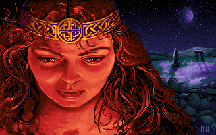
BELTAINE CUSTOMS
The festival of Beltaine, which literally means "Bel's fire"
(Beal-teinne) marks the beginning of the summer and the light half of
the Celtic year. Traditionally, all fires were extinguished on the eve
of Beltaine, to be re-lit from the sacred 'needfire' kindled at dawn.
The Celts were predominantly pastoral people and Beltaine was the time
when the cattle were put out to their summer grazing on the higher
slopes. The cattle were driven through the sacred Beltaine fires for
purification. The sacred fire would also, it was believed, bring
protection, good fortune and fertility to the people.
It was also the time when young Celtic warriors would put their fighting
skills to the test in the challenges of the Beltaine Games. With the
hard work of planting accomplished, it was a time when the clans came
together in celebration of the sun and to hope that the crops would grow
and flourish in the months ahead.

SURVIVING BELTAINE CUSTOMS
There are numerous folk customs that have until recently taken place at
this time of year throughout Britain, and which clearly show surviving
traits of this ancient pagan festival. As far as we know, the last
public Beltaine festival to be held on Arran was as late as 1895. The
men of a certain townland made a need-fire (tein-eigen) and kept it
burning with sacred faggots on Beltaine eve. Local people drove their
herds through the fire.
The Beltaine fires and festivals went on all over the Highlands until
the mid-nineteenth century. Also, in the Shetlands dancing went on
around the bonfires and it was considered lucky to jump over the flames
without injury. The Shetland fires were kept going for three days.
THE CLOUTIE WELL
Beltaine rites still take place at the famous Cloutie Well in
Inverness-shire. This well is situated on Culloden moor and is known by
various names, such as Tobar Ghorm (the Blue Well) and Tobar n'Oige
(Well of youth). Cloutie means a cloth or rag. These clouties are tied
on the surrounding trees by pilgrims to make a wish. Wells were seen by
the Celts as bringers of good health. The well is visited by Highlanders
on the first Sunday of May, that being the day dedicated to the sun.
People arrive long before dawn (and originally should have been away
from the well before sunrise, however this is no longer observed).
Before drinking from the well you must first walk three times 'sunwise'
around it, and offer a silver coin. Finally, you must tie a rag to an
over-hanging tree.
ARTHUR'S SEAT
Arthur's seat, Edinburgh, is a traditional site of Beltaine fires which
were lit at sunrise. Many people still climb to the top of this summit
to watch the May sunrise.
MAY DEW
Growth requires not just the fire of the sun, but also moisture. The dew
of Beltaine gathered before dawn was considered particularly beneficial.
People who were sprinkled with May dew were assured of health,
happiness, and in the case of young women, beauty. All over Scotland
young girls go out on May morn to bathe their faces in the dew. To
ensure a good milk supply, dairymaids would draw a rope made from the
tails of Highland cattle through the May dew grass saying:
"Bainne an te so shios,
bainne an te so shuas,
'nam ghogan mhor fhein"
(Milk of this one down, milk of that one up, into my own big pail).
BELTAINE BANNOCK
As well as the widespread lighting of Beltaine bonfires on moors or
hilltops throughout the Highlands, a special cake or bannock would be
made using eggs, milk and oatmeal. These bannocks, which were kneaded
entirely by hand and should not come into contact with steel, were being
made up until the end of the nineteenth century.
In Perthshire, one piece of the bannock cake would be blackened with
charcoal and distributed along with the other pieces. Whoever drew this
piece out of the bonnet had to leap three times through the flames.
Unlike the Gaulish druids, we have no evidence of human sacrifice
committed by the late Bronze Age Celts of Alba. By this time the
'scapegoat' or Fool served a very important role in that it was believed
that any ill-fortune would fall to that person, sparing the rest of the
people.
In Inverness-shire, within living memory, children would meet on a small
hill on the first of May to prepare a fire. They each took an egg, a
specially baked bannock and a piece of cheese. One side of the bannock
was marked with a cipher to signify death or misfortune. The bannocks
were rolled down the hill, and when they came to rest the children's
fates were revealed. However, this was all done in a very light-
hearted manner, but nevertheless it is a clear survival of the
scapegoat.
THE FAIRIES
At Beltaine it was long believed by Highlanders that the fairies, or
Good People, were abroad. To combat their enchantments (fairies were
prone to stealing milk from cows, or even turning it sour) rowan crosses
were hung in byres, and domestic animals were sprinkled with water from
holy wells. It was particularly important that no fire (kindling) should
be given away at this time - a survival of the Celtic festival when all
hearth fires were extinguished and could only be re-lit from the sacred
need-fire.
*Used with the permission of the Dalraida Celtic Heritage Trust
Thursday, December 26th, 2019
Attention
visitors: Tartans.com is back. Please note that this is a snapshot of the site as it existed nearly 20 years ago and you may encounter broken links; we are still combing through the site and correcting those as we find them. Please also note that some sections are currently not functional, primarily the discussion forums/clan chat boards.


